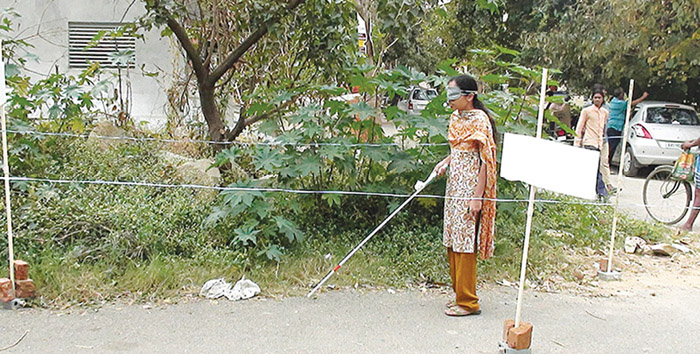Companies from various countries have tried in the past to develop a solution for the mobility of the visually impaired, but they have somehow always managed to produce devices that are super expensive and complicated. That was until a team from India decided to try their hand at it.
When a third of the world’s visually impaired reside in India, it made perfect sense for IIT Delhi and the Saksham team to design and test an affordable device to help such people. Funded by Wellcome Trust, the UK, and manufactured by Phoenix Medical Systems, SmartCane comes with an assortment of features and still manages to retail at an affordable price.
The story behind…
Back when members of the design team were undergraduates, they attended a design-oriented course in embedded system design. Their aim was to identify a challenge, and design and develop a functioning solution for it. With this in mind, the team visited National Association for the Blind (NAB) at R.K. Puram, New Delhi.

Their mentor, Prof. Balakrishnan, had the team meet Dipendra Manocha, who at that time was present at the technology division of NAB. Even though he himself is visually impaired, he has devoted his life creating and developing solutions for the blind. He identified that, mobility is something that is fundamentally important. The condition is such that independent mobility has become a challenge, due to which a blind person cannot go out to work or get education.
Why not the simple white cane
It is not that we currently do not have a solution; we do, but it provides limited functionality. We are all aware of the white cane. It gives texture information and information about things on the ground. However, it has a major limitation—it cannot detect anything from the knee to the head.
Open windows in a corridor, railings or signboards are not easily visible due the height of their placement. When a blind person walks near any of these objects, he or she could bump into these, which may cause serious injury.
Perhaps, worse than getting injured, the person might become fearful when stepping out of the house, which, in turn, might limit his or her social interaction.
The design process
The design team figured that they needed to develop something that could fit onto the white cane, yet be kept as a detachable device. This way, if the cane broke after prolonged use, the user could simply replace the cane and keep the device (and attach it to a new cane).
The second thing they considered was to ensure that sensors could detect objects/movements from the knee to the head. This had to be done in such a way that the device complemented the cane.
Once these issues were taken care of, the next challenge was identifying the best way to let the user understand the information that sensors picked up. While audio was what some of their competition went with, they chose to not go that route. This was because blind people usually have a very keen sense of hearing, and the team did not want to meddle with that by delivering beeping sounds. It also makes it difficult for the person to hold a conversation because the device would emit sounds all the time. Moreover, it could isolate the person even further from his or her surroundings.
As a result, the team decided to go for tactile feedback in the form of vibration patterns. The system for delivering vibrations had to be designed in such a way so as to compensate for the many variations we see in a diverse country like India, like different heights, different ways of holding the stick and everyday situations.
To tackle this, the team decided to deliver vibrations to a larger part of the unit, but this meant using more power. As a result they had to ensure that hardware and electromechanical design was done in such a way that it reduced power consumption.
Finally, the device’s aesthetics including colour, form factor and shape were also given due consideration because of the dignity aspect.
While cost-sensitivity was something they strived for, they had to ensure that this did not affect the robustness and reliability of the device. They had to make sure that the device would not break easily, as getting a replacement might pose a problem. This is where the team, led by Sashi Kumar and Dr A. Venkatesan, from Phoenix Medical Systems came in. They helped sort out manufacturing issues by taking care of the design, which accounts for quality, robust usage during testing, fabrication aspects and others. They also helped with interference testing and ensuring compatibility with necessary certifications.
The team knew that aesthetics counts, even for the blind. They rejected white colour for the cane as it has medical significance; whereas, they concluded black had negative connotation and a colour like red was extreme. They finally settled on off-white, with blue and green options. The design team addressed these special needs so that their customers felt valued as end users and were not simply given something frivilous.







